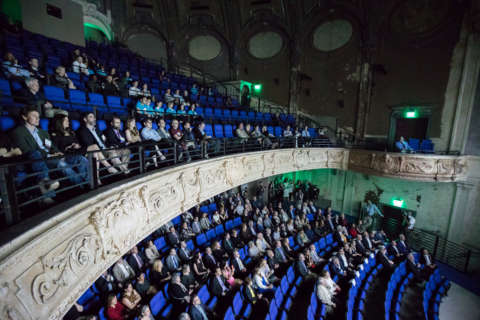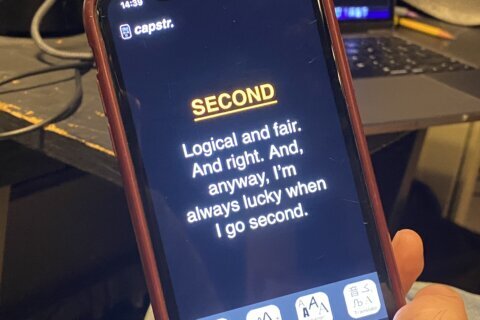This article is the second in a two-part series on the Strathmore program. Read our conversation with 2022 Artist in Residence Langston Hughes II here.
Strathmore’s “Artist in Residence” program has been changing lives for years.
Just ask Christylez Bacon, who turned his beatboxing into Grammy acclaim.
“It’s like a good music school program that is free and you actually get paid to perform,” Bacon said. “You get press, you get good professional photos, all these great things. I think Strathmore is doing a really good thing because they’re breathing a different type of life into our local music scene, creating opportunities for people on the local level.”
Born in Southeast D.C., Bacon grew up in the Washington Highlands neighborhood.
“My mother used to be a DJ before I was born,” Bacon said. “She could find a sample in any recording and tell you where it comes from. … Being a kid from Southeast, we had go-go … coming out of cars on the radio. We as kids in the neighborhood would gather buckets and trash cans, bang on them and do a big go-go drum circle on a weekly basis.”
The makeshift buckets and trash cans evolved into making beats with his mouth.
“We couldn’t afford drums,” Bacon said. “I would always make these sounds out of my mouth. My mother pulled me aside and played me a Doug E. Fresh album and let me know that what I was doing was beatboxing. From there, I knew that these random sounds could be put together to form rhythms and create this instrument as the human beatbox.”
He says beatboxing is a personal instrument that no one can take from you.
“If you lose your voice, if you become hoarse, you can still beat box,” Bacon said. “It’s not dependent on the vocal cords. It’s just the sound that is created from pushing air through the tongue and the teeth and the lips, so you could have no vocal chords and still do this.”
He soon attended the Duke Ellington School of the Arts as a visual arts major.
“You had to have formal education and we didn’t have that,” Bacon said. “I only had one music class in elementary school. You had to know how to read sheet music. I didn’t know any of that … but I also had the talent of drawing, painting and sculpting, so I got in through that and started moonlighting in the instrumental music department.”
He joined a creative writing program at Martha’s Table by Tim Jones and Bomani Armah.
“He would take me out to all the D.C. clubs and open-mics to perform,” Bacon said. “We ended up in The Washington Post and that’s how Strathmore connected. … They were looking in the weekend section and saw this feature on me called ‘When Hope Meets Hip-Hop.’ … ‘Yo, we need to have this cat sign up for the Artist in Residence program.'”
He admits that he had never heard of Strathmore, which seemed worlds away.
“It wasn’t on my radar,” Bacon said. “As a hip-hop artist where I come from, those places weren’t accessible to us, like Kennedy Center and Strathmore. I didn’t even know about Strathmore because it was outside of D.C. … I was like, ‘Artist in residence? Do I have to live there?’ I didn’t even know this terminology! There are some cultural differences here.”
So in 2007, he applied to audition, but accidentally got on the Metro the wrong way.
“Strathmore has its own Metro stop, Grosvenor-Strathmore, I’m thinking it’s all the way out in Dunn Loring on the Blue or Orange Line, so I start heading in the opposite direction,” Bacon said. “Folks in my community weren’t really going all the way out there. I missed my audition time, straight up. Back then, you couldn’t just get everyone on the cellphone.”
Thankfully, he got himself turned around to audition later that day.
“I course corrected and I was so stressed out and learned a really good lesson there,” Bacon said. “One lesson is plot your direction before you go. But the larger lesson was: once you course correct and start going on the road for change, stressing out about what you did wrong isn’t going to fix the situation at that point, you just got to ride the wave.”
His audition landed him a spot in the 2007 Artists in Residence program.
“I was really excited because my cohort would be these jazz musicians, experimental classical folks, pop-classical crossover folks,” Bacon said. “I’m like the only one of my kind, a hip-hop artist mixed with go-go, trying to mix all these flavors together. … That one event and them doing that outreach definitely changed the trajectory of my career.”
The program served as his biggest education, musically and financially.
“They’d say, ‘Hey Chris, my dude, this is a viola, you don’t just put it on the treble clef,'” Bacon said. “What they were teaching … was business management stuff. How are you managing your finances? How do you do taxes as an artist? … That business portion is important. It’s the difference between being a starving artist and a fed artist.”
His residency also included two public performances at Strathmore.
“I always wanted to mix together string sections from classical, horns from jazz, all of this stuff with my rap, hip-hop, go-go,” Bacon said. “Now I’m in this position like, whoa, I’ve got these other Artists In Residence around me, I can finally pull together these people and make this idea a real thing. … I start learning how to write sheet music, reading books.”
One day, his Strathmore mentor Cathy Fink, a Grammy-winner with partner Marcy Marxer, was waiting for a file to transfer from a hard drive to a laptop and asked to collaborate.
“Cathy Fink, who is just a G in music … pulls out this banjo,” Bacon said. “I start beatboxing over it, thinking of all the different rhythms I could put over it. She says, ‘I think we’ve got something here, we should collaborate on a project together.’ She brings in her partner Marcy Marker and we start mixing together old-time banjo, beatboxing, rapping.”
It became the Grammy-nominated children’s album “Banjos to Beatbox” (2010).
“I’m on 13th and U Street in front of the Rite Aid chilling with my home girl and the person from the local Grammy chapter calls on my cellphone: ‘Chris, you’ve been nominated for a Grammy, get your outfit together, come to L.A. and walk the red carpet,'” Bacon said.
Just like that, he made his first trip to Los Angeles for the Grammy ceremony.
“We hit that red carpet,” Bacon said. “I see T-Pain and Usher and I’m like, wow, everyone’s short! … When the bodyguards part, it’s Beyoncé! She’s freakin’ 20 feet away from me! … My publicist is like, ‘Hey Chris, turn around, meet Doug E. Fresh.’ I’m like, wow, this is the guy my mom played for me and got me introduced to beatboxing.”
Bacon ultimately lost to Ziggy Marley, but there are no winners and losers in the arts.
“Ziggy Marley won that joint,” Bacon said. “If Ziggy Marley wasn’t there, we probably would have hit it. … I don’t really get starstruck, I try to think for other people like I don’t want to stress anybody out. I’m a little hood dude from Southeast. I just give them a nod real quick, and if a person seems open to chop it up, I chop it up with them.”
Since then, the Grammy and Strathmore labels have furthered his career.
“Just having that attached to my story, it helps legitimize things,” Bacon said. “They’re like, ‘Let me check his resume. Oh, Grammy nomination.’ It helps cut to the chase. … The National Symphony Orchestra and Kennedy Center are the holders of my orchestral library. ‘Oh, you need the stuff for my song ‘Mumbo Sauce?’ Call the NSO librarian.'”
Today, he runs a collaboration series called Washington Sound Museum.
“I started doing it in a small place called BloomBars every month collaborating with different artists from different countries,” Bacon said. “Then I took it to the Atlas [Performing Arts Center] and blew it up so I could have lights, stage design. … These collaborations put me in a position to collaborate with NSO on four occasions.”
Through it all, he’s learned a valuable lesson about the music industry.
“I realized on the red carpet, being around anyone, the person that performs at a dive bar, the person that performs on TV and at festivals in front of thousands of people, we are all doing the same thing,” Bacon said. “It’s all connected, just one’s on TV, one’s not.”
Listen to our full conversation here.








